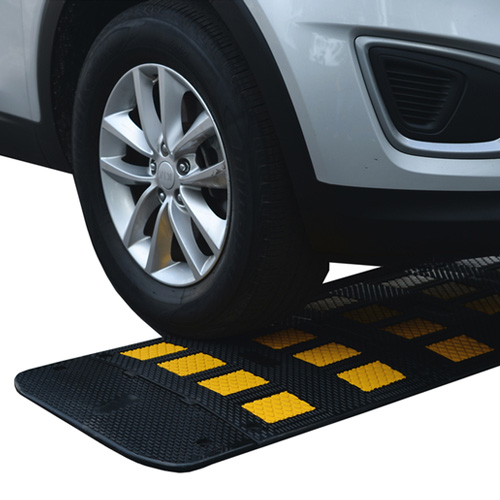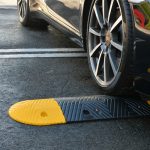[et_pb_section bb_built=”1″][et_pb_row][et_pb_column type=”4_4″][et_pb_button _builder_version=”3.19.18″ button_text=”SHOP NOW” button_url=”https://unimat-traffic.com/products/speed-bumps-humps/” button_alignment=”right” background_layout=”dark” custom_button=”on” button_icon=”%%114%%” custom_margin=”-184px|||” button_bg_color=”#e02b20″ button_icon_color=”#ffffff” button_on_hover=”off” box_shadow_style=”preset2″ /][et_pb_text _builder_version=”3.19.18″]

In England a sleeping policeman refers to a raised band across a road, designed to make motorists reduce their speed. This term was created by a physicist named Arthur Holly Compton in 1953 when he designed the first ramp to slow down traffic outside his University, that ramp was similar to the speed bumps that we use today. They may have various names but they are still used as a traffic calming device to make roads safe. So make sure next time you visit England you know what people refer about when they mention the term “Sleeping Policeman”.
What does sleeping policeman mean in Britain?
Although the earlier implementation of what might be considered speed bumps happened on June 7, 1906, it wasn’t until 1953 when a physicist and winner of the Nobel Prize Arthur Holly Compton invented what he called “traffic control bumps” the basic design for the speed hump after noticing the speed at which motorists passed Brookings Hall at Washington University in St. Louis, Missouri, where he was chancellor.
The British Transport and Road Research Laboratory published a comprehensive report in 1973 examining vehicle behavior for a large variety of different bumps geometries. At the time speed humps were not permitted on public roads but had been installed on private roads.
According to a publications by the Institute of Transportation Engineers, the first bump in Europe was built in 1970 in the city of Delft in Netherlands. Later that decade in Britain, people adopted the word Sleeping Policeman to call Speed Bumps since they remain in the way, sleeping until a motorist needs a physical remainder not to speed.
| SKU | Description | Length | Height | Width | Weight |
|---|---|---|---|---|---|
| SB206FT | 6 Ft Speed Bump (1) 6′ Section With no End Caps | 72″ | 2″ | 12″ | 48.40 |
| SB207FT | 7 Ft Speed Bump (1) 6′ Section + (2) End Caps | 86″ | 2″ | 12″ | 55.40 |
| SB213FT | Single Lane 12 Ft Speed Bump (2) 6′ Section With no End Caps | 144″ | 2″ | 12″ | 96.80 |
| SB219FT | Double lane 19 Ft Speed Bump (3) 6′ Section + (2) End Caps | 230″ | 2″ | 12″ | 152.20 |
| SB225FT | 25 Ft Speed Bump (4) 6′ Section + (2) End Caps | 302″ | 2″ | 12″ | 200.60 |
| SB2ECAP | End cap | 7′ | 2′ | 12′ | 3.50 |
| SKU | Description | Length | Height | Width | Weight |
|---|---|---|---|---|---|
| SB3039I | 39″ Speed Bump (1) 39″ Section With no End Caps | 39″ | 2″ | 13.7″ | 36.20 |
| SB3117I | 117″ Single Lane Speed Bump (3) 39″ Sections With no End Caps | 117″ | 2″ | 13.7″ | 108.60 |
| SB3137I | 137″ Single Lane Speed Bump (3) 39″ Sections + (2) End Caps | 137″ | 2″ | 13.7″ | 124.20 |
| SB3234I | 234″ Double lane Speed Bump (6) 39″ Sections With no End Caps | 234″ | 2″ | 13.7″ | 217.20 |
| SB3254I-2 | 254″ Double Lane Speed Bump (6) 39″ Sections + (2) End Caps | 254″ | 2″ | 13.7″ | 232.80 |
| SB3ECAP-2 | End cap | 10″ | 2″ | 13.7″ | 7.80 |
| SKU | Description | Length | Height | Width | Weight |
|---|---|---|---|---|---|
| SH1018I | 18.75″ Speed Bump (1) 18.75″ Section with no End Caps | 18.75″ | 1.25″ | 2″ | 22.20 |
| SH1112I | 112.5″ Single Lane Speed Bump (6) 18.75″ Sections with no End Caps | 112.5″ | 1.25″ | 2″ | 133.20 |
| SH1128I | 10 Ft Single Lane Speed Bump (6) 18.75″ Sections + (2) End Caps | 128.5 | 1.25″ | 2″ | 148.80 |
| SH1225I | 225″ Double Lane Speed Bump (12) 18.75″ Sections with no End Caps | 225″ | 1.25″ | 2″ | 266.40 |
| SH1241I | 20 Ft Double Lane Speed Bump (12) 18.75″ Sections + (2) End Caps | 241″ | 1.25″ | 2″ | 282.00 |
| SH1ECAL | LEFT End Cap | 8″ | 1.25″ | 2′ | 7.80 |
| SH1ECAR | RIGHT End Cap | 8″ | 1.25″ | 2′ | 7.80 |
| SKU | Description | Length | Height | Width | Weight |
|---|---|---|---|---|---|
| SH2019I | 19.75″ Speed Bump (1) 19.75″ Section With no End Caps | 19.75″ | 2″ | 3″ | 48.00 |
| SH2121I | 10 Ft Single Lane Speed Bump (5) 19.75″ Sections + (2) End Caps | 121.75″ | 2″ | 3″ | 273.00 |
| SH2240I | 20 Ft Double Lane Speed Bump (11) 19.75″ + (2) End Caps | 240″ | 2″ | 3″ | 561.00 |
| SH2ECAL | LEFT End cap | 11.5″ | 2″ | 3′ | 16.00 |
| SH2ECAR | RIGHT End cap | 11.5″ | 2″ | 3′ | 16.00 |
How do you install a Speed Ramp?
Speed cushions are a type of speed hump installation designed to alleviate the negative impacts that vertical deflections have on emergency vehicle response times. Speed cushions installations are typically made up of several small speed humps installed across the width of the road with spaces between them. They force normal cars to slow down as they ride with one or both wheels over the humps. Meanwhile, they allow fire engines (and other large vehicles) with wider axles to straddle the cushions without slowing down. Installing these Speed Ramps is very easy, all you need is a drill and the right bolts for concrete and then it is a simple as 1, 2 and 3: 1. You mark the place where the Speed Ramp will be, 2. You drill thru the pre-manufactured holes in the rubber bump, and 3. You tight the bolts to secure a perfect installation.
What’s the difference between a speed hump and a speed ramp?
The answer to this question is simple since a Speed Hump is a lighter device made to dramatically slow down the vehicles because of its barrier effect while Speed Ramps are much wider and they’re made only to slow down vehicles without making them fully stop. Both products are made for the same purpose but for different places depending on the speed limits in certain places. At the end of the day they’re both a solution and a sleeping policeman waiting for its chance to help increase the safety on any road.
[/et_pb_text][/et_pb_column][/et_pb_row][/et_pb_section]



